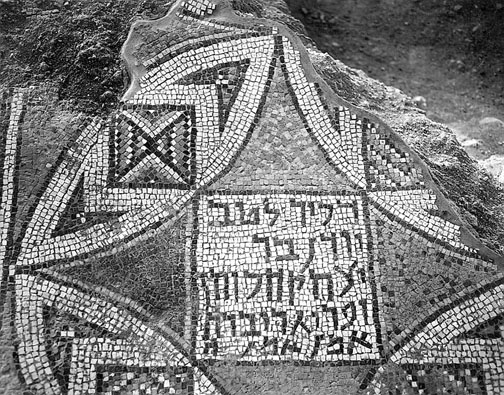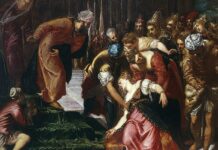A 1,500 to 2,100-year-old Hebrew text from Jerusalem refers to “Shalom, mother of the synagogue.” And two burial niche inscriptions from Beit She’arim in the Galilee, both dated 250 to 350 C.E., refer in Greek to “Sara daughter of Nehemiah, mother of the priestess, the lady Maria.”
“These inscriptions tend to provide little detail, so it is hard to know what to make of some of them,” Michael Satlow, professor of Judaic studies and religious studies at Brown University, told JNS. “What on earth it meant for a woman to be a priestess of a synagogue, for instance, is very unclear.” There is no male equivalent, of which Satlow is aware, of “mother of the synagogue,” he added.
The three are among some 5,250 already digitized texts and their translations documented in the Inscriptions of Israel/Palestine project, which Satlow directs. The project, which began at the University of Virginia in 1996 and moved to Brown in 2002, aims to make 10,000 inscriptions from 500 BCE to 614 C.E. accessible online.
“Once deciphered, these inscriptions are then often published in specialized scholarly journals or excavation reports,” Satlow told JNS. “Only in recent decades have serious attempts been made to collect these inscriptions and make them more widely available.”
The inscriptions, written on durable materials like mosaics and stone, during the period that the project explores in Israel are largely in Aramaic, Hebrew, Greek and Latin. Although composed by people many centuries ago, some things—like Jewish donors taking credit on synagogue walls—have remained the same.
Despite widespread assumptions that synagogue leadership was patriarchal, an inscription from Huldah appears to name two women, Eustochion and Hesychion, as a synagogue’s “founders.” Satlow also cited several references to synagogue donations that name Jewish women. “Remembered be for good Yudan son of Isaac the Priest and Parigri his daughter. Amen. Amen,” reads an Aramaic mosaic, 400 C.E. to 500 C.E., from a synagogue in Tzipori in the Galilee.

Rome wasn’t built in a day …
That Aramaic mosaic is entirely preserved, but many of the inscriptions in the project are partial fragments. To make matters harder to translate, many have “irregular” spelling and syntax, according to Satlow. An element of interpretation is part of every translation of the text, he added.
One of the most striking inscriptions in the project, to Satlow, is a text found near Beit Guvrin that dates between 98 C.E. to 117 C.E. Bar-Ilan University professors Boaz Zissu and Avner Ecker have translated the five-word Aramaic inscription as: “May the memory of Lord Trajan Caesar be blessed.”
“This is all quite surprising, since the emperor Trajan violently suppressed Jewish dissidents during the Kitos War,” from 115 C.E. to 117 C.E., Satlow said. He noted that the inscription, “most oddly,” uses a formula typical of honoring synagogue patrons.
“All of this seems to suggest that, at least for some of the local Jewish population, the Roman military presence in Idumaea (Edom) may have been welcome,” Satlow said.
Some evidence suggests that Roman soldiers were regular customers at an olive oil press nearby. “No doubt this led to a great deal of ambivalence,” he said. “The Roman policing was probably not a particularly pleasant presence, but the influx of soldiers’ cash had obvious benefits.”
Inscriptions in the project also shed light on Roman roads and the Bar Kochba revolt, according to Satlow.
Studying the inscriptions has helped scholars come to new understandings of trade routes at the time and to reconstruct the ancient Roman road system. Evidence suggests that Rome constructed a vast paved road network for military reasons, according to Satlow. The empire wanted soldiers to be able to move quickly from one place to another, particularly if war or revolts broke out.
“Although Rome’s infrastructure appears impressive in retrospect, it wasn’t—as the saying goes—built in a day and instead took many generations to achieve this expanse,” he said. “This process seems to have begun in 69 C.E. during the Jewish War [Great Revolt], paving existing paths to facilitate the siege of Jerusalem soon after.”
After the paved roads were completed, inscriptions show how satellite military outposts, as in Emmaus, supported the larger garrison in Jerusalem, according to Satlow.
“We can trace how the road connecting Emmaus to Jerusalem facilitated a flow of goods to the latter—the milestones erected by the soldiers paving these roads indicated how far it was to the destination, along with the emperor under whom the road was paved,” he said. And along the 30-mile road from Eleutheropolis to Jerusalem, civilians would have seen 29 reminders of the emperors and military units who created the infrastructure, just as a governor’s or mayor’s name would appear on signage today crediting them for construction projects.
Roman roads also facilitated access, for tax collectors and government officials, to previously unreachable places, like the rural Galilee economy, which had a form of subsistence farming without money, according to Satlow.

“Once these roads were paved, it became easier to transport goods from urban centers to these rural areas,” he said. “On the one hand, this contributed to greater social inequality, on the other hand, this facilitated things like literacy and architectural achievements.”
A synagogue in Capernaum appears to have received “significant donations” soon after a path nearby was paved into a road under Trajan. A more ornate Jewish house of worship replaced it, “thanks in part to the economic flow through the otherwise unremarkable village,” Satlow said.
The Bar Kochba revolt, from 132 C.E. to 135 C.E., has divided scholars, some of whom take it to be a minor revolt and others who think it spread throughout Judea.
“For a long time, the debate revolved around a number of archaeological debates, but in 1999, the classicist Werner Eck suggested a compelling reading of an inscription that had been known since 1978,” Satlow said. That inscription from 136 C.E. on a triumphal arch appears to celebrate the emperor Hadrian’s triumph in the Bar Kochba revolt.
“What is striking about this inscription is that it was found in the otherwise insignificant site of Tel Shalem” in the Beit She’an Valley, he said. “This inscription, combined with a bronze statue of the emperor Hadrian, suggests that it was an important military site during the revolt—that the battles were widespread to the point where there may have been panic among the Romans.”
After Bar Kochba, there is no more evidence of a military legion that appears in prior inscriptions. That silence, Satlow said, “suggests that the unit was either devastated or disbanded on account of the losses it suffered in the Bar Kokhba War.”

























